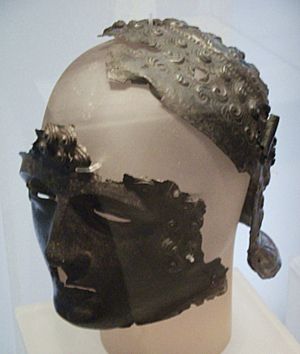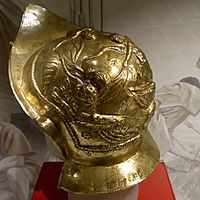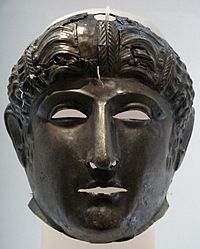Newstead Helmet facts for kids
Quick facts for kids Newstead Helmet |
|
|---|---|

The Newstead Helmet
|
|
| Material | Iron |
| Created | Roman, 80–100 AD |
| Place | Newstead, Roxburghshire |
| Present location | National Museum of Scotland, Edinburgh |
| Registration | X.FRA 121 |
The Newstead Helmet is a special iron helmet made by the Romans almost 2,000 years ago, between 80 and 100 AD. It was found in 1905 at the site of an old Roman fort in Newstead, Scotland. Today, you can see it at the National Museum in Edinburgh.
This wasn't a helmet for fighting in battles. Instead, it was worn by Roman cavalry soldiers (soldiers on horseback) for special parades and shows called hippika gymnasia. The man who found it, Sir James Curle, called it "one of the most beautiful things that the receding tide of Roman conquest has left behind."
How Was the Helmet Found?
In 1905, an archaeologist named James Curle was digging at a Roman fort called Trimontium. The fort was named after the three peaks of the nearby Eildon Hill, as Trimontium means "three hills."
While digging, Curle and his team found many Roman army artifacts. These included armor, equipment for horses, and several fancy helmets. The most amazing find was the Newstead Helmet, which was discovered in a pit. It was the only one that still had its face mask attached.
What Does the Helmet Look Like?
The helmet is made of two main parts: a piece for the head and a mask for the face. Both are made from beaten iron. When it was found, the helmet was crushed and broken, but archaeologists have carefully put it back together.
The outside of the helmet was once plated with shiny silver or tin. Inside, there were pieces of a soft woollen lining to make it more comfortable. The back of the helmet has a rim with a thin bronze plate decorated with a chevron pattern.
The mask is designed to look like the face of a young person with curly hair. A laurel wreath is carved into the hair, which might show an influence from Celtic styles. On the side of the helmet, there is a small tube. This tube was used to hold colorful feathers for decoration during parades.
A Roman writer named Arrian described what these parades looked like:
The horsemen wear gilded helmets of iron or bronze, to draw... the gaze of the spectators. Unlike the helmets made for active service, these... are made to fit round the faces of the riders with apertures for the eyes... From the helmets hang yellow plumes... As the horses move forward, the slightest breeze adds to the beauty of these plumes.
This means the helmets were made to be flashy and impressive, not just for protection.
Other Helmets Found at Newstead
The Newstead Helmet wasn't the only one found in the pit. Archaeologists also discovered other amazing helmets and masks.
- The Cupid Helmet: A beautiful bronze helmet was found with detailed pictures on it. On one side, the Roman god of love, Cupid, is shown riding a chariot pulled by two leopards. On the other side, a winged figure, probably the goddess of Victory, holds a palm branch. This helmet probably had a face mask too, but it is now missing.
- A Legionary Helmet: A simpler iron helmet was also in the pit. This one was a standard helmet worn by regular Roman foot soldiers, known as legionaries. It had hinged pieces to protect the cheeks.
- A Bronze Mask: In another part of the fort, a separate bronze face mask was found. It shows a young face with curly hair. It has holes under the ears, which were likely used to attach it to a helmet.



